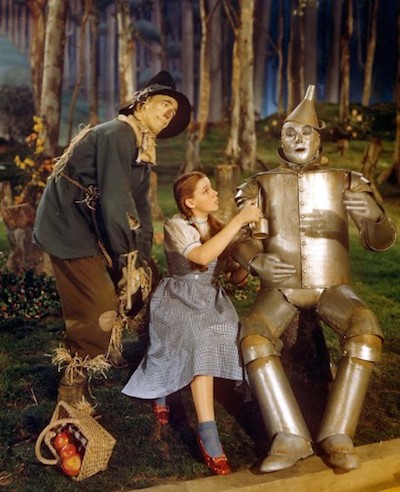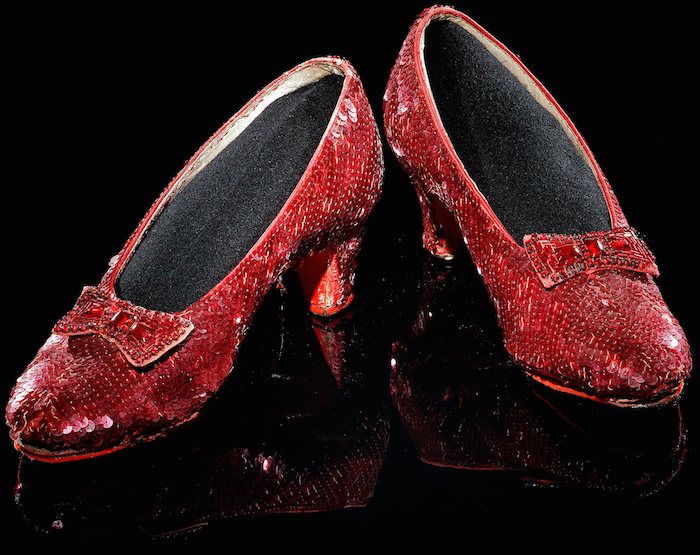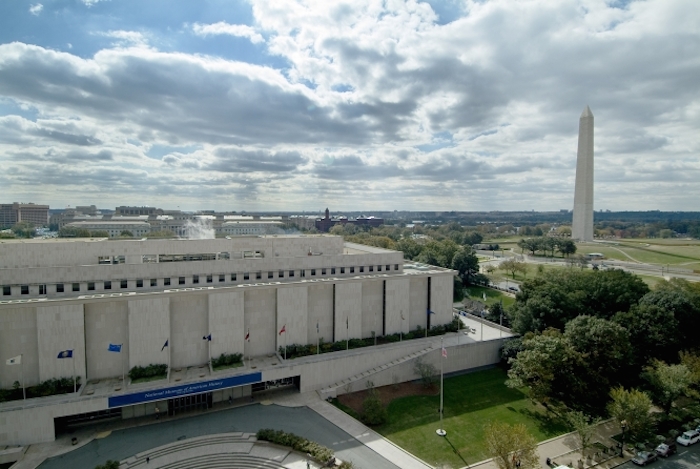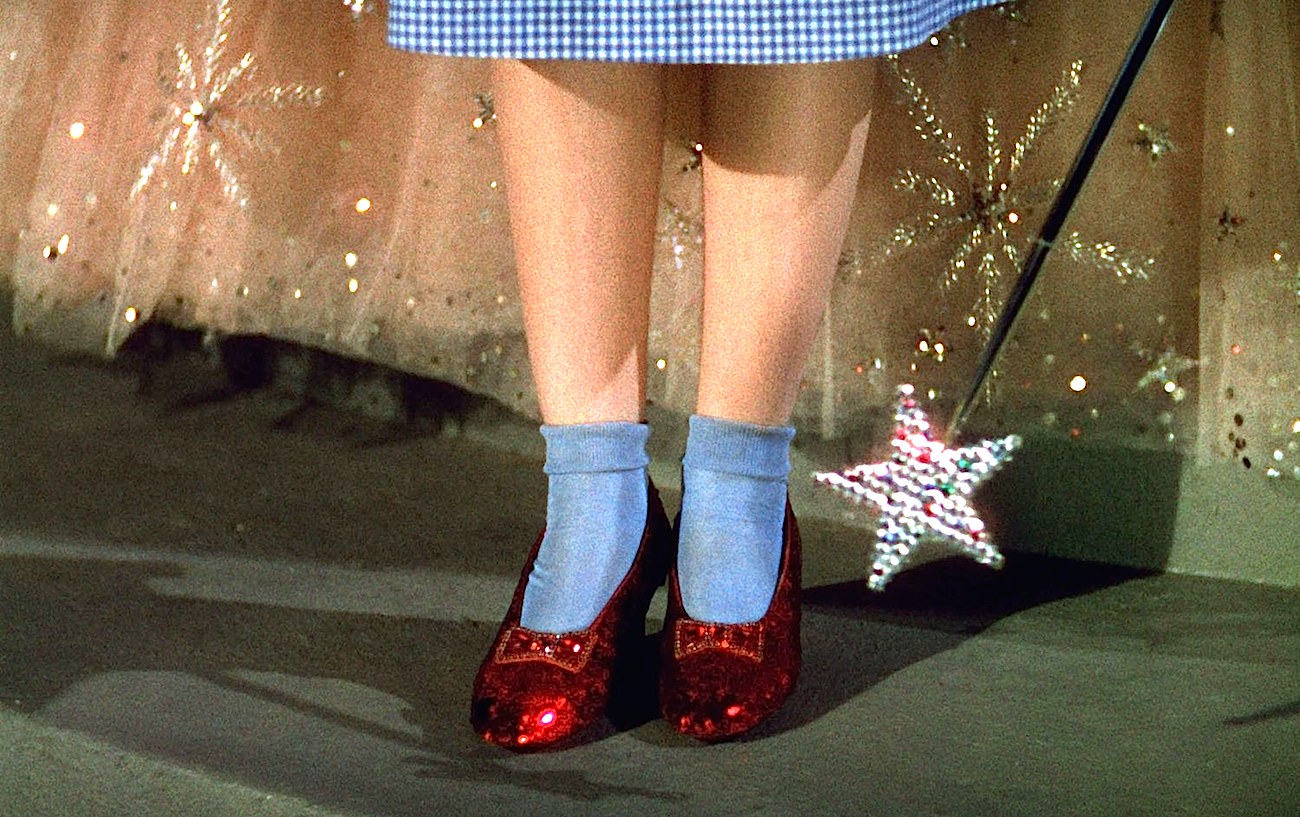 Earlier this week, the Smithsonian’s National Museum of American History in Washington, D.C. launched a Kickstarter campaign to fund the conservation and display of the Ruby Slippers that Judy Garland wore in the 1939 MGM classic The Wizard of Oz. The slippers have been on view at the museum for three decades and they are one of the Smithsonian’s most asked-about objects. The goal of the Kickstarter is $300,000. There are different levels of contribution with different perks and rewards, from posters and t-shirts to private tours of the museum and custom hand-sewn replicas of the Ruby Slippers. I spoke to curator Ryan Lintelman about how the funds raised in this campaign will be used.
Earlier this week, the Smithsonian’s National Museum of American History in Washington, D.C. launched a Kickstarter campaign to fund the conservation and display of the Ruby Slippers that Judy Garland wore in the 1939 MGM classic The Wizard of Oz. The slippers have been on view at the museum for three decades and they are one of the Smithsonian’s most asked-about objects. The goal of the Kickstarter is $300,000. There are different levels of contribution with different perks and rewards, from posters and t-shirts to private tours of the museum and custom hand-sewn replicas of the Ruby Slippers. I spoke to curator Ryan Lintelman about how the funds raised in this campaign will be used.
Danny Miller: As a curator of the Smithsonian’s entertainment collection, you clearly have the best job on the planet.
Ryan Lintelman: (Laughs.) I definitely feel the same way!
It’s very exciting that the Kickstarter for the Ruby Slippers has taken off this week in such a big way, but I think the first question most people have when they hear about it is why the Smithsonian needs outside financial help for such a project.
The federal government gives us about 65% of our budget but that’s really just to keep the lights on and pay the salaries, it’s not enough for special projects like this. Usually we go to corporations or wealthy individuals for such funding, but for this campaign we wanted to reach out to people who love classic Hollywood and who love The Wizard of Oz and the Ruby Slippers so they can feel like they’re part of it. We like to call this artifact “the nation’s Ruby Slippers” since of the several pairs that exist in the world, these are the only ones that are in public hands.
What’s happening to the Ruby Slippers that made you start this campaign?
Being a fan of classic Hollywood, I’m sure you know that most of the costumes and props that were made back then were really designed just to last during the filming. These shoes are now almost 80 years old and really starting to show their age. Some of the sequins have fallen off, the soles are starting to pull away, there are fraying threads, and then there is just the damage that all objects on display in museums for long periods of time can endure: light, humidity, and temperature fluctuations that discolor them so they no longer have quite have the same brilliant ruby color that they did at one point. We want to give our highly trained conservators here at the museum the opportunity to go in there and do a very thorough cleaning and stabilization of the sequins and then to build this new state-of-the-art display case that’s going to keep them in great condition in the years to come.
Are there purists who worry about you doing any work on them at all — that such efforts might make them less “authentic?”
Yes, we’ve been getting a lot of questions about “restoring” or “refurbishing” the slippers and that’s definitely NOT what we’re doing. Those words, at least in the museum world, refer to adding things — like adding new sequins or coloring the shoes in some way. That’s not what we’re doing, we just want to “conserve” them, to stop the deterioration and preserve them as they are. They’re going to look a lot better because of the very careful cleaning but we’re not adding anything that would take away from their historic value. They will still be the same Ruby Slippers that came off Judy Garland’s feet in 1939!
When I hear about the new display case, isn’t the one they’re in now properly controlled?
Yes, it was state-of-the-art in its day, but the technology has greatly improved and this one is going to be more along the lines of the case that holds the Declaration of Independence and the Constitution. The Ruby Slippers are a national treasure and obviously an icon of Hollywood. We like to call them the most famous shoes in the world! So we want to really push the science — we’re working with the National Science Foundation to come up with this case that’s going to be totally hermetically sealed and filled with an inert gas so that there will be no oxygen carrying any type of bacteria that could start to eat away at the material the slippers are made from. This is going to be true state-of-the-art in a way that’s never been done before.

I’ve seen several versions of the Ruby Slippers although the first one I saw was the one at the Smithsonian which is just gorgeous. How do you know for sure how the particular pair you have was used?
These came from MGM’s famous auction that they had in 1970. They hired Kent Warner who was a Hollywood costume designer to organize the auction and they let him go into all the prop houses and costume shops at the studio to pull out interesting items. They asked him to find “the” Ruby Slippers and bring them out for auction. The pair we have was the one sold at that time. They were sold for $15,000, which was considered a fortune at that time, to an anonymous bidder who then donated them to the Smithsonian. Other versions of the Ruby Slippers were eventually sold over time. There are two pairs in private hands and one pair that now belongs to the Academy of Motion Picture Arts & Sciences that will be a big part of their museum they’re building in Los Angeles. There is also the “Arabian” test pair of the slippers that was owned by Debbie Reynolds for a long time.
Yes, I saw that pair at one of her auctions a few years ago, they were amazing to see!
And there was also a pair from the film that was won by a young girl in a radio contest in 1940. One of these pairs was stolen from the Judy Garland Museum in Grand Rapids where it was on loan. There’s a new documentary that we participated in that traces the history of all of the pairs.
Is it the markings and the wear in the Ruby Slippers that helps you know how this particular pair was used in the film?
Yes, there are different patterns of wear but another thing we can point to is the felt that is applied to the soles. There are a few pairs that do not have this felt so we know those were the ones used in close-ups in the film. They’re sometimes referred to as “the witch’s shoes” because they were used in the scene where they’re still on the legs of the Witch of the East under Dorothy’s house when the Wicked Witch of the West wants them back. But our pair does have well-worn felt on the soles and our scholars believe they were one of the workhouse pairs that were used in most of the dancing sequences. But there’s also evidence that we may have a mismatched pair — that when Kent Warner found them he might have picked a left and right shoe from two different pairs because one is a 5C and one a 5BC.
Oh, wow. Could one have been used by Judy Garland’s stand-in?
No, she wore a size 6 and there is a pair in that size that we know was hers. It may be that Judy Garland’s feet were slightly different but they might just be from two separate pairs that were used on the film. One reason that we think that there were probably at least seven pairs of Ruby Slippers at one time is that one of our shoes is labeled “Judy Garland 1” and the other one is labeled “Judy Garland 7.”
Fascinating. Of course it’s a miracle any of those items survived! I remember that Debbie Reynolds also had a few versions of Judy Garland’s dress, I wonder where those ended up.
Yeah, all that stuff is sort of scattered to the winds now.
Do you have other items from The Wizard of Oz in your collection?
Yes, we have the Scarecrow’s costume that was donated to us by the widow of Ray Bolger many years ago. He actually wore it on stage for years after the filming of The Wizard of Oz and she also donated the original raffia that it was stuffed with. That’s definitely one of our treasures. We also have one of the original shooting scripts for the film where you can see “silver shoes” crossed out by hand and the words “ruby slippers” written in which is a great thing to show people since, as I’m sure you know, the were silver shoes in the original L. Frank Baum book but were changed to take better advantage of Technicolor. And, speaking of that, we have one of the original Technicolor cameras on display at the museum that was used to film The Wizard of Oz.

Cool. I was very excited to read about the new “On With the Show” permanent exhibit that’s being created for the museum. Will all of your priceless entertainment items be moved to that when it opens?
Yes! Our museum has been under renovation for the past 10 years or so and we’ve been opening up floor by floor. We opened up a new permanent exhibit on American Business History last year, and we’re doing one next year on American Democracy and Immigration. In 2018, we’ll open a whole new wing of the museum that will focus on culture in American Life. We’re calling it “On With the Show” right now but that may change. It will look at the whole of American history through the lens of popular culture — everything from colonial theater and how that influenced the Revolution through classic Hollywood and television with our items from All in the Family and The Muppets and stuff we’ve collected recently from Breaking Bad and Mad Men. We want to show how culture often operates as a forum for Americans to discuss what’s happening in their world. We’re super excited about it because we’re going to be able to put so many items out from our collection that have never seen the light of day before.
Ooh…such as?
We have Ginger Rogers’ dresses from Top Hat and Follow the Fleet, we have some great props from the original silent Ben-Hur, we have a lot of William S. Hart stuff including one of his Colt revolvers. We have a great collection of early Mutoscope viewers and reels that I’ve done a lot of work on. We also have a lot of stuff from our more recent movie collections such as Indiana Jones’ whip and jacket, props from Rocky, Alien, The Matrix, and lots of others. And we have droids! We have the original C3PO and R2D2 that were used in Return of the Jedi!
Wow, I can’t wait! It must be very heartening to see the early enthusiastic response to this Kickstarter campaign.
This is our dreamed-of response so far. The incredible thing to me is that thousands of people have already made contributions so it’s not just a few rich people making big contributions, it’s much more grass-roots, that’s really encouraging. I work with these objects every day so it means so much to me that so many peope really care about them.

